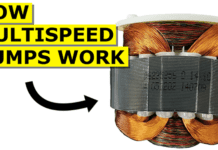What is a Volume flow rate?
Volume flow rate is the measurement of how much fluid is flowing past a selected point over a length of time. Engineering designs, specifications and schematics often list volume flow rates. We measure a volume flow rate in the SI units of meters cubed per second (m3/s) but you will often find them listed as litres per second (l/s) or litres per hour (l/h). In the US it will still be listed in British Imperial units of cubic feet per second (ft3/s).
Volume flow rate is often listed as Vdot or a V with a dot above it e.g.
Other common flow rate measurements include
- Velocity flow rate (m/s)
- Mass flow rate (kg/s)
In this article we will focus only on volume flow rate, to learn about the others simply follow the links above. If you find this article interesting and useful please like and share, you can also comment at the bottom of the page.
How is volume flow rate measured?
There are two main ways to measure the volumetric flow rate.
- Let the fluid flow into a measuring tank over a length of time
- Calculate it from either the velocity or mass flow rate
The first method usually isn’t practical but it is very simple. Just let the fluid flow into a measuring tank over a period of time then divide the measured volume (m3) by the lenght of time (s) to get m3/s.
The second method is the most common approach in industry because the fluid is not disturbed in the process, this allows real-time data analysis for processes and services. To calculate the volume flow rate, you need to know the average velocity and the cross-sectional area. The volume flow rate is then calculated by simply multiplying the two together.
You will need some additional equipment to measure the velocity. There are a number of instruments and equipment to measure the velocity such as an Orifice plate, venturi meter, Pitot tube, Turbine or Ultrasonic meter.
lets look at an example of a pipe.
Example
You’ve been asked to calculate the volumetric flow rate inside a pipe, you find that the average velocity inside the pipe is 2m/s and the pipes inside diameter is 0.5m. First calculate the cross-sectional area (CSA) of the pipe by: CSA =(π x Diameter2) ÷ 4CSA = (3.142 x 0.5m2) ÷ 4 = 0.196m2Then multiply the CSA by the average velocityVdot = 0.196m2 x 2m/s = 0.393m3/s or Vdot = 0.393m3/s * 1000 = 392.7 l/s
It can also be calculated if you know the mass flow rate and the fluids density. Let’s look at another example.
Example
You’ve been asked to calculate the volumetric flow rate inside a pipe, you find that the mass flow rate is 389.6 kg/s and that the fluid flowing inside the pipe is 40°c water at a pressure of 101.325kPa.
First you need to lookup the density of water at that pressure and temperature, luckily we have already tabulated this for you click hereDensity = 992.22kg/m3Mass flow rate = 389.6kg/sVolume flow rate = 389.6kg/s ÷ 992.22kg/m3 = 0.393m3/sAnswer = 0.393m3/s
What affects volume flow rate?
It is important to remember that volume flow rate will change with temperature and pressure! the volume flow rate will also change if there is a constriction in the pipe/duct, this is because the mass flow rate is constant, this means that in a constriction the velocity must increase so that the mass flow rate into the pipe equals the mass flow rate out of the pipe, if the velocity increase then the volume flow rate increases.
Summary
- Volume flow rate is measured in m3/s
- Volume flow rate changes with pressure and temperature
- Volume flow rate changes with velocity
- Volume flow rate can either be calculated or measured
- Volume flow rate is calculated from the cross sectional area and the velocity or by dividing the mass flow rate by the fluid density.




















Thank you for sharing this informative blog. will it work the same for different kinds of chemicals or a paddle wheel flow meter will be required to get accurate results ?
Thank you.
All thanks to sir I have been head sick for these notes
Thank you very much for your valuable information.
Thanks for sharing this valuable information. The other day I asked a friend of mine about the difference between m3/sec and cmc/sec, he said they are the same unit… How comes?
Was very helpful 🙂